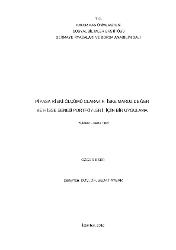| dc.contributor.advisor | Aybar, Sedat | en_US |
| dc.contributor.author | Eser, Özgür | |
| dc.date.accessioned | 2019-07-12T08:37:14Z | en_US |
| dc.date.available | 2019-07-12T08:37:14Z | en_US |
| dc.date.issued | 2010 | en_US |
| dc.identifier.uri | https://hdl.handle.net/20.500.12469/2119 | |
| dc.description.abstract | Son yıllarda, finansal kurumlarda piyasa oynaklıklarının etkilerini kontrol etmek amacıyla, piyasa risklerinin yönetiminin önemi artmaktadır. Risk yönetiminin bir yaklaşımı olan Riske Maruz Değer (RMD) hem uygulayıcılar hem de denetleyici kurumlar tarafından benimsenmektedir. Geleneksel olarak bankalar, serbest fonlar, emeklilik fonları, yatırım fonları ve yatırım ortaklıkları Riske Maruz Değer`i piyasa riskini ve yatırım performansını ölçmek amacıyla kullanmaktadırlar. Bu tezin amacı, hisse senedi portföylerinde piyasa riski ölçümü olarak Riske Maruz Değer`in etkinliğini analiz etmektir. Riske Maruz Değer hesaplama süreçleri birçok varsayımı ile birlikte farklı istatistiksel tekniklere dayanmakta ve genel olarak tek kabul görmüş bir hesaplama yöntemi bulunmamaktadır. Farklı Riske Maruz Değer yöntemleri oldukça farklı sonuçlar vermektedir. Bu nedenle, Riske Maruz Değer metodunun seçimi önemli olmaktadır. Bu çalışma, iki farklı RMD yöntemini incelemekte ve sonuçlarını karşılaştırmaktadır. Yöntemlerin doğrulukları geriye dönük testlerle test edilmiştir. Sonuçlar Riske Maruz Değer hesaplama süreçlerinde en önemli faktörün volatilite tahmin yöntemi seçiminin olduğunu göstermektedir. | en_US |
| dc.description.abstract | In recent years, the importance of managing market risk has increased among financial institutions to control effects of market volatility. There are many different methods of measurement market risk. One approach to risk management called Value at Risk (VaR) has been accepted by both practitoners and regulators. Traditionally, banks, hedge funds, pension funds, mutual funds and investment trust use VaR method to measure market risk.The aim of this thesis is to analyze effiency of Value At Risk method as a measurement market risk in equity portfolios. Value at Risk computing processes are based on different statistical techniques with many assumptions and there is no generally accepted way to calculate it. Different methods of computing VaR generate widely varying results. Thus, the choise of VaR method is very important.This study examines two different VaR methods and compares results. The accuracy of the methods were tested by backtesting. The results show that the choice of volatility forecast method is the most important factor in VaR computing processes | en_US |
| dc.language.iso | tur | en_US |
| dc.publisher | Kadir Has Üniversitesi | en_US |
| dc.rights | info:eu-repo/semantics/openAccess | en_US |
| dc.subject | Riske Maruz Değer | en_US |
| dc.subject | Volatilite | en_US |
| dc.subject | EWMA | en_US |
| dc.subject | Geriye Dönük Test | en_US |
| dc.subject | Value at Risk | en_US |
| dc.subject | Volatility | en_US |
| dc.subject | Backtesting | en_US |
| dc.title | Piyasa riski ölçümü olarak riske maruz değer ve hisse senedi portföyleri için bir uygulama | en_US |
| dc.type | masterThesis | en_US |
| dc.department | Enstitüler, Lisansüstü Eğitim Enstitüsü, Sermaye Piyasası ve Borsa Ana Bilim Dalı | en_US |
| dc.relation.publicationcategory | Tez | en_US |
| dc.identifier.yoktezid | 257270 | en_US |
















